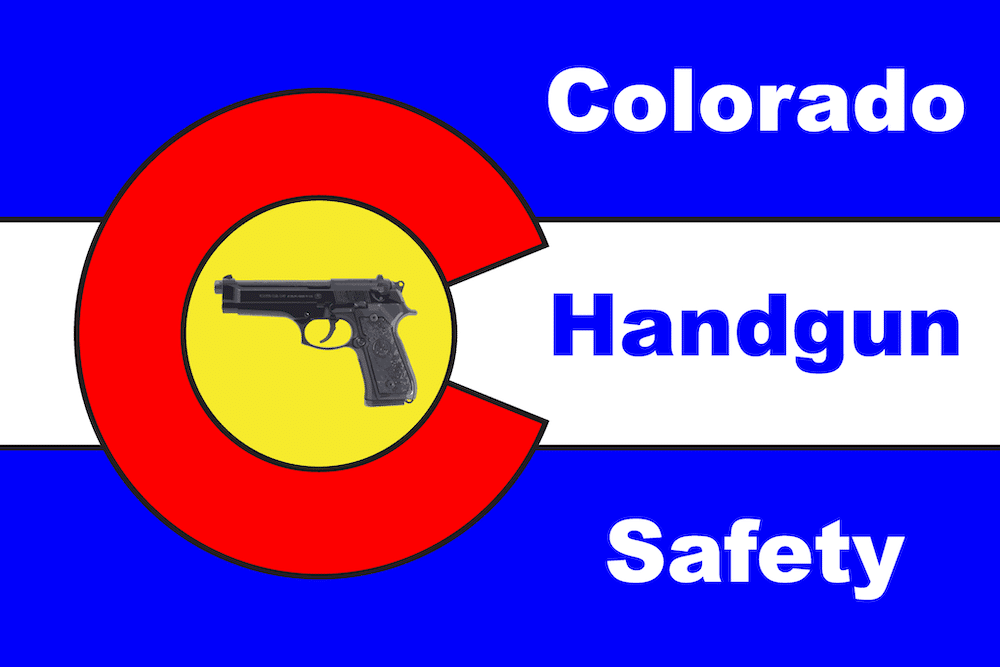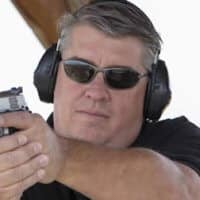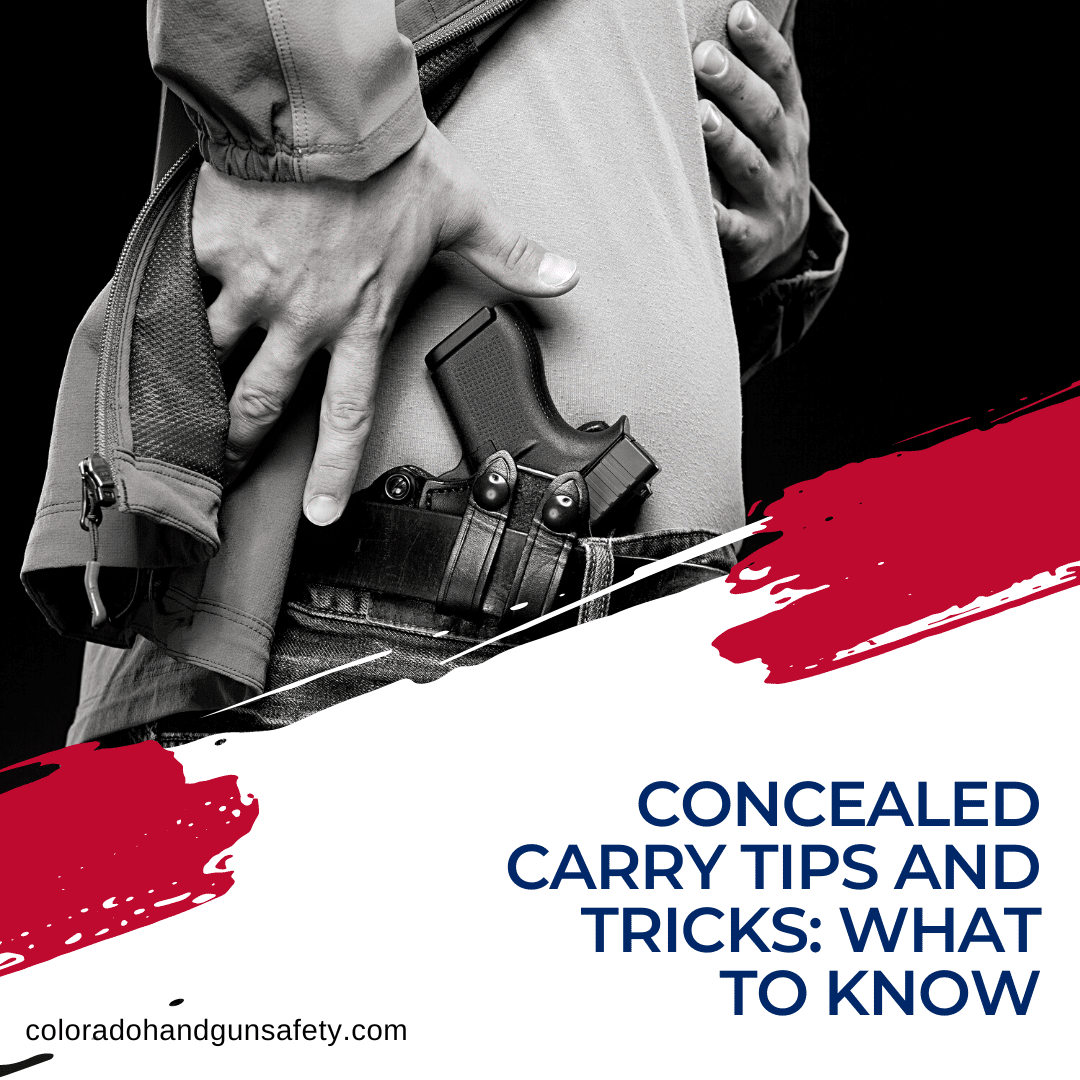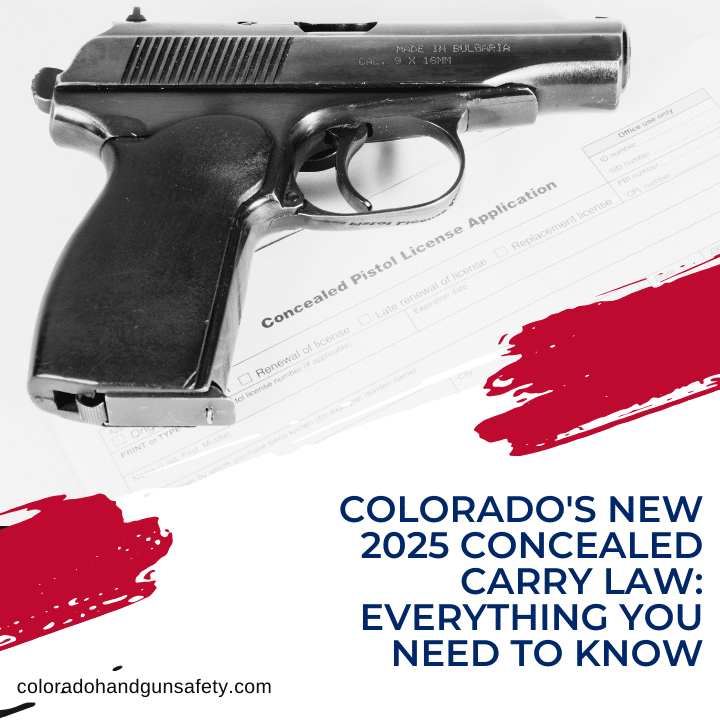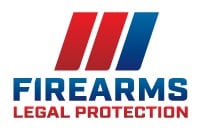Whether you’re an experienced or new handgun owner, you know that concealed carrying is not a decision to be taken lightly. Plus, if you’re like most concealed carriers in Colorado, you’re looking for the best way to protect yourself and your family should the need arise.
With that enormous responsibility comes the need to keep on top of training and safety best practices. That’s why we’ve gathered the following tips and tricks from experienced gun experts at Colorado Handgun Safety so you can be sure you’re keeping yourself safe.
Here are our top 10 concealed carry tips and tricks to remember while carrying your handgun.

1. Pass Your Concealed Carry Class
The first order of business before you can legally carry a concealed handgun is to make sure you’ve passed a concealed carry class. This class is designed to give you an overview of the fundamentals of handgun safety and the legalities of owning and carrying a concealed weapon.
You can expect to pay anywhere between $60 and $100 in Colorado for your class. CCW classes are eight hours long and include live-fire, so plan your day accordingly.
Once you’ve passed, you’ll be issued a certificate of completion to present to your local sheriff’s office when applying for your concealed carry permit. Then, after they take photos and fingerprints and submit your application with a background check, you will be issued your permit within 90 days.
2. Choose The Best Handgun For Your Needs
Now that you know how to get your concealed carry permit, it’s time to decide which handgun is right for you. First, consider what type of handgun you feel most comfortable shooting.
Research several different brands and models to ensure you select the one that best fits your lifestyle and needs.
The size, weight, caliber, capacity of the magazine, and ease of operation — all of these factors play a role in choosing your handgun. In addition, here are some other considerations you should make when deciding on a firearm:

Handgun Reliability
You don’t want to buy a gun and have issues with its reliability. Instead, you should always be comfortable with the reliability of your handgun and not doubt its ability to fire each time.
While choosing the right handgun is a personal preference, these models tend to be popular with beginner concealed carry permit holders:
- Glock 19 Gen5
- Mossberg MC1sc
- Kahr CW9
- Smith & Wesson M&P 9MM
- Beretta PX4 Storm
Handgun Comfortability
You should also consider how comfortable you are with the handgun. Comfortability includes the grip size, trigger pull, and recoil of your chosen gun.
It’s essential to be comfortable and confident when carrying so that you can be sure you’re ready in any situation.
Make sure you can also control the other parts of your handgun, such as the safety, hammer, magazine catch, de-cocking lever, and slide stop, without issue.
Handgun Accuracy
Having an accurate firearm is vital when it comes to concealed carry. You want a handgun that shoots straight and accurately every time. When you practice at the range, pay attention to how accurate your shots are from different distances.
Typically, in self-defense, you won’t be shooting from more than 15-20 yards away. Unfortunately, statistics on the average self-defense shooting distance can be challenging to find as the FBI doesn’t publish this information.
However, we know from 2019 FBI law enforcement data that most killed officers were shot from 0-5 feet away.
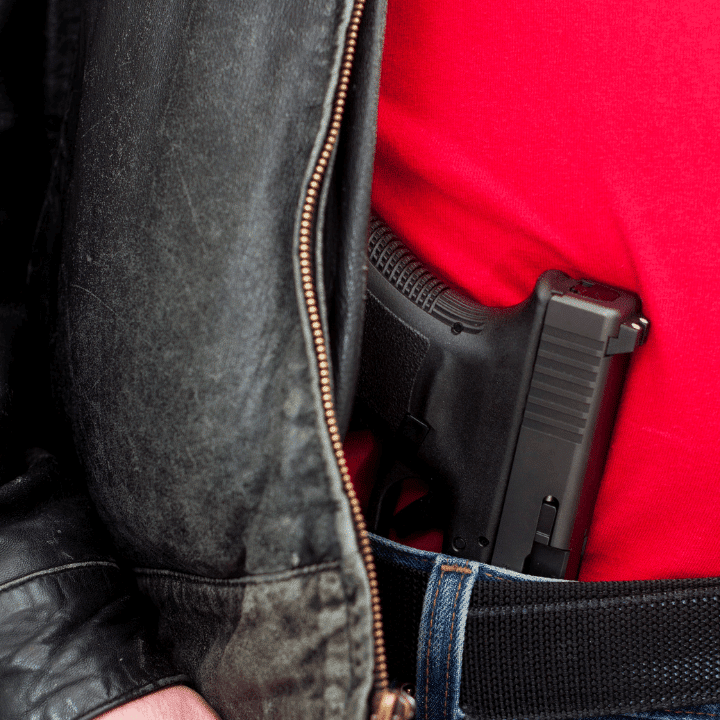
3. Select The Right Ammunition
The ammunition you choose for your handgun is just as necessary as the gun. The type of ammo you should use depends on your caliber firearm and your purpose in carrying it.
We recommend using full metal jacket (FMJ) rounds for self-defense purposes.
These rounds tend to penetrate deeper than hollow-point bullets and can cause more damage to the target, and if stopping power is your goal for self-defense, FMJ is the way to go.
On the other hand, if you’re more concerned about accuracy and precision when shooting, hollow points may be the right ammo to get. These bullets expand more upon impact and are designed to fly in a straighter line than FMJ.
4. Get The Right Concealed Carry Holster
Choosing the right holster is crucial in being a responsible concealed carry holder. You want to ensure your handgun is secure and out of sight.
When deciding on a holster, consider the design, its security, and its comfortability. Ensure you find a holster that meets all these criteria and won’t print when you carry it.
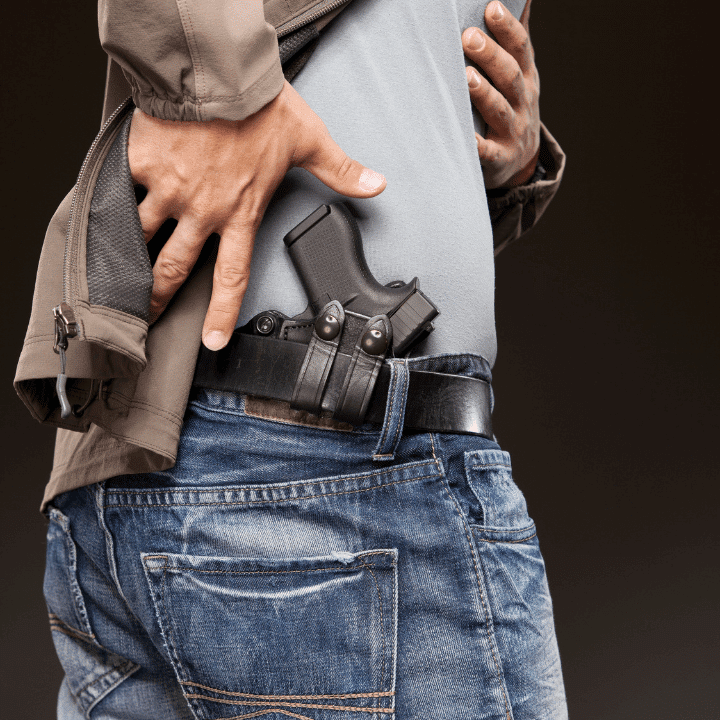
Holster Durability
You’ll want to ensure your holster is durable and can withstand regular wear and tear. In addition, you should look for holsters made from strong materials such as nylon or Kydex, as these tend to last longer than leather holsters.
Finally, you should make sure the holster fits your handgun correctly — too tight, and it may require extra effort to draw your gun; too loose, and it could slip out when you don’t want it to.
Holster Safety
In addition to durability, you should look for a holster that includes safety features such as retention straps or locking mechanisms.
These are designed to keep your gun secure and reduce the risk of it falling out when you’re on the move. Some holsters even come with safety mechanisms that can be adjusted to increase or decrease retention.
Holster Comfortability
When carrying a concealed weapon, you want to ensure you’re comfortable. Ensure the holster fits securely against your body so it won’t slip or move around. You’ll also want to be comfortable with the holster’s positioning.
For instance, if you plan to carry your handgun in your waistband, make sure the holster sits at a comfortable height. Pay attention to access too. You want a holster that’s easy to draw from but not so easy that it can be removed without your knowledge.

5. Figure Out How You Want to Conceal Carry
Once you have your handgun and holster, it’s time to decide how you want to carry. Many people carry their handguns in a concealed holster on the waistband of their pants.
This is a popular option because it’s usually comfortable and easy to access. There are two main options: inside-the-waistband (IWB) and outside-the-waistband (OTW).
The IWB holster is typically smaller and more discreet. It’s also easier to conceal because it sits closer to the body. However, this type of carrying can be uncomfortable for some people and may require an undershirt or a jacket for added comfort.
On the other hand, an OTW holster is larger and bulkier. This type of holster sits outside your waistband and is more evident to people around you. It’s typically used for open carry but can be concealed with a jacket or other clothing item.
No matter which option you choose, make sure that you practice drawing your handgun from its holster regularly to ensure you’re comfortable and confident with your concealed carry technique.
6. Understand The Gun Laws Near You
It’s crucial to familiarize yourself with the local gun laws before carrying a concealed firearm. Different states have different regulations for concealed carry, so you want to make sure you stay up-to-date on the current laws in your area.
For example, additional restrictions may exist for specific places, such as schools or government buildings.
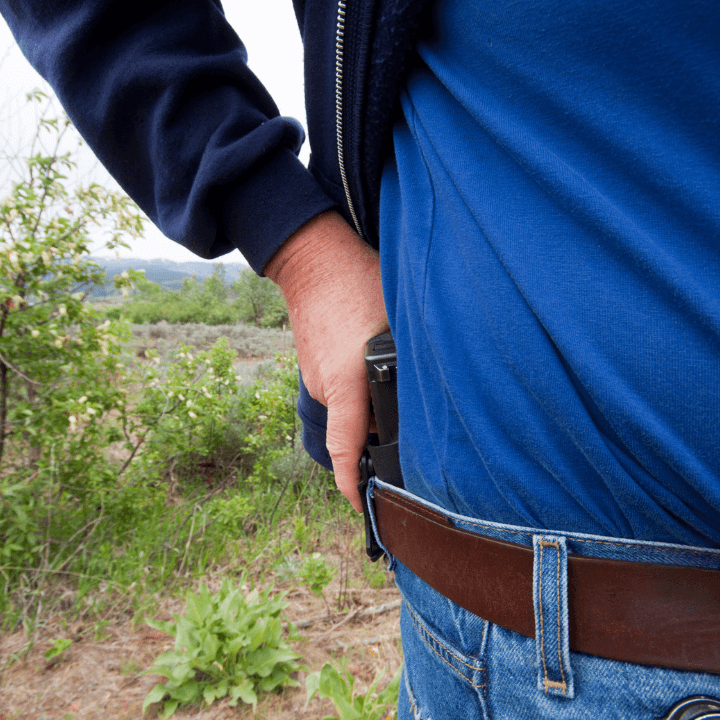
7. Dress For Your Handgun
When carrying a concealed handgun, it’s essential to dress appropriately. For example, avoid wearing tight-fitting clothing such as skinny jeans or spandex.
These materials can cause your holster and gun to be more visible. Instead, opt for looser-fitting clothes such as khakis or baggy jeans.
You should also select an appropriate jacket or vest that will help conceal your gun if needed. Look for items with plenty of pockets deep enough to cover your firearm entirely in public.
The goal is to avoid “printing,” which is when the shape of your gun is visible through your clothing.
8. Carry Your Handgun at All Times
Once you’ve got your concealed carry permit and the right firearm, ammunition, and holster, it’s time to hit the road.
It’s important to remember that handguns should only be carried with a valid concealed carry license. Also, follow all local laws when carrying your firearm in public places.
In addition, you should always carry your handgun with you. This way, you can get used to the feeling of having a concealed weapon and be prepared in case of an emergency.

9. Remember Not to Touch Your Handgun in Public
Remember that you should never touch your handgun in public. Carrying a concealed gun means keeping it out of sight and out of everyone else’s reach.
Going to touch your handgun or adjusting it in its holster will draw unnecessary attention to you and your weapon. Instead, keep it secure in its holster at all times.
If you’ve invested in the right concealed carry holster for your handgun, it will be kept safe and secure, even when you’re on the move.
You should also avoid talking about your firearm or showing it off to others, even if they are friends or family members. This could be seen as a sign of intent and may cause alarm among those around you.
10. Continue to Practice Your Handgun Safety Skills
No matter how much experience you have with carrying a concealed handgun, you must keep practicing your safety skills. This means regularly seeking out additional firearm training and handgun classes for refreshers.
Additionally, take the time to research firearm laws, safety tips, and best practices for carrying a concealed handgun so that you can stay safe and knowledgeable about your rights as a gun owner.
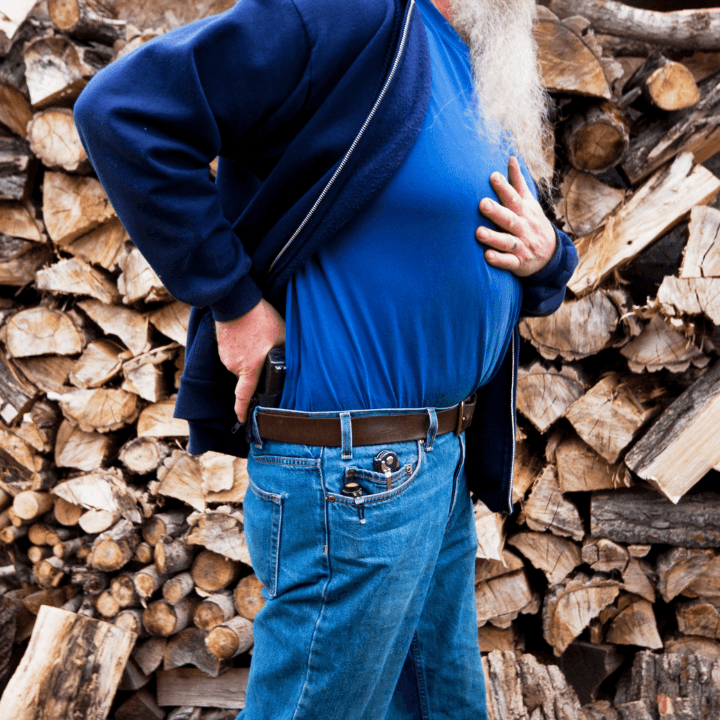
Take Your Concealed Carry Class With Colorado Handgun Safety
Following these tips and tricks, you can become a responsible concealed carry handgun owner in no time. Keep practicing your safety skills and stay informed about the laws in your area to be confident and prepared while carrying your firearm.
Colorado Handgun Safety offers concealed carry classes and other firearms training classes to help you understand the ins and outs of concealed carry. Our NRA-certified instructors are here to help you become a responsible and knowledgeable gun owner. So take a CCW class with us today to start your journey!
